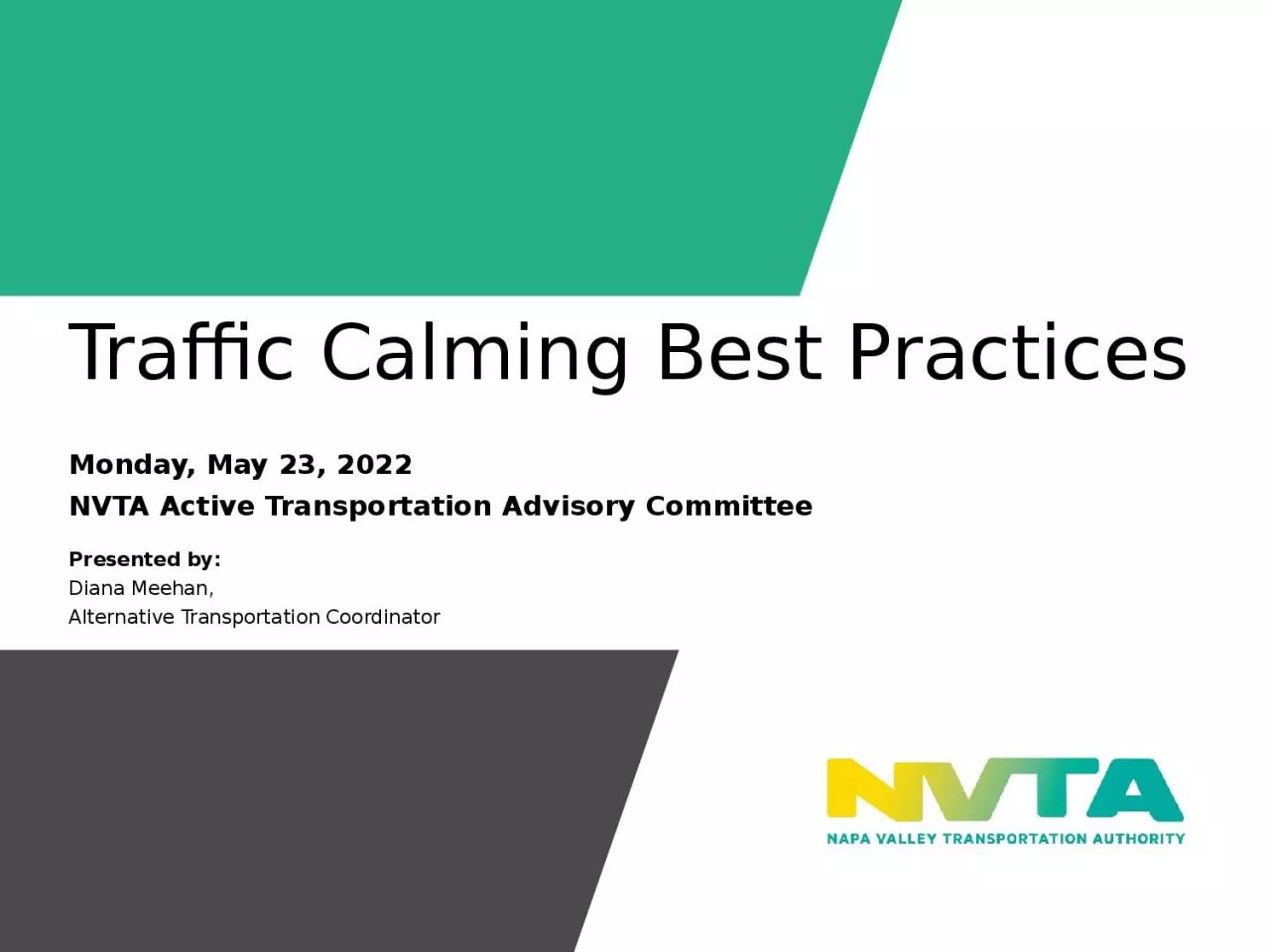

Presented by Diana Meehan Alternative Transportation Coordinator Monday May 23 2022 NVTA Active Transportation Advisory Committee 2 Description from the Institute of Traffic Engineers ITE ID: 1047926
Download Presentation The PPT/PDF document "Traffic Calming Best Practices" is the property of its rightful owner. Permission is granted to download and print the materials on this web site for personal, non-commercial use only, and to display it on your personal computer provided you do not modify the materials and that you retain all copyright notices contained in the materials. By downloading content from our website, you accept the terms of this agreement.
1. Traffic Calming Best PracticesPresented by:Diana Meehan, Alternative Transportation CoordinatorMonday, May 23, 2022NVTA Active Transportation Advisory Committee
2. 2Description from the Institute of Traffic Engineers (ITE):The combination of measures that reduce the negative effects of motor vehicle use, alter driver behavior, and improve conditions for non-motorized street users.What is Traffic Calming?
3. 3Why Traffic Calming?Speeding is one of those negative effects! This slide from a Metropolitan Transportation Commission Vision Zero presentation provides startling statistics for the Bay Area roadways
4. 4Traffic Calming GoalsDecrease vehicles speedsReduce collisionsImprove speed limit complianceImprove safety for bicyclists and pedestriansDecrease crash severity when crashes do occurIncrease bicycle and pedestrian activity (mode shift)Create a more user-friendly environment for roadway users
5. 5Traffic Calming Strategies Road Diet-Before and AfterCurb extensions/Bulb outs Chicanes Speed Cushions
6. 6Traffic Calming Strategies Rectangular Rapid Flashing Beacon (RRFB) Traffic Circles
7. 7Traffic Calming Strategies Roundabouts First St./Third St. @ California Blvd. in Napa
8. 8Traffic Calming StrategiesRoad DietsReconfiguration of existing roadway Typically 4-lane to 3-lane Addition of bike lanes and/or transitBest on roadways with average daily traffic volumes between 10,000-15,000Benefits safety response-emergency vehicles can travel the center turn lane
9. 9Traffic Calming StrategiesChicanesSeries of alternating mid block extensions or islandsSlow vehicle speeds by narrowing roadway and adding curves, discouraging speeding Create landscape space, greeningCan be used on one side of street with parking on opposite sideCan be created by alternating parallel parking with perpendicular parking
10. 10Traffic Calming StrategiesCurb extensions/bulb-outs
11. 11Traffic Calming StrategiesSpeed CushionsConsist of humps or tables to slow vehicle speedsCut outs allow large emergency vehicles to pass unimpededBikes can travel through cut outsInclude high visibility markings
12. 12Traffic Calming StrategiesRectangular Rapid Flashing Beacon (RRFB)Pedestrian actuated signal to indicate crossingHigh visibility rapid flashing pulse rateAlerts vehicles early to allow slowing for pedestrians crossingEffective at multilane crossings with speeds under 40mph
13. 13Traffic Calming StrategiesTraffic CirclesTypically used on residential streetsHelps manage vehicles speeds by altering courseCan be shapes other than circular, especially at locations where neighborhood streets intersect with busier streetsCan be implemented using lower cost materials to test effectiveness
14. 14Traffic Calming StrategiesRoundaboutsReduces vehicles speeds at higher volume intersectionsSignificantly reduces conflicts over traditional intersection designReduces conflict severity Reduces crossing distance for pedestriansPedestrians only cross one direction of travel at a timeProvides separate path of travel for cyclists less comfortable traveling in traffic
15. 15Traffic Calming Costs are variable depending on treatment Traffic Calming MeasureHigher Cost(Over $250K)Lower Cost(under $100K)Quick Build or Demonstration?Road DietsXNot typicalChicanesXYesCurb Extensions/Bulb-outsXYesSpeed CushionsXNot typicalRectangular Rapid Flashing Beacons (RRFB)XNot typicalTraffic CirclesXYesRoundaboutsXNoCosts for traffic calming treatments are variableSome treatments can be implemented using “quick build” techniques-using paint, plastic or lower cost materials to demonstrate effectiveness prior to investing in permanent solutionsSome solutions are higher cost to implement, but are lower cost to maintain-such as roundabouts
16. 16Safer Speeds = Safer Streets
17. Questions??Presented by:Diana Meehan, Alternative Transportation Coordinatordmeehan@nvta.ca.gov